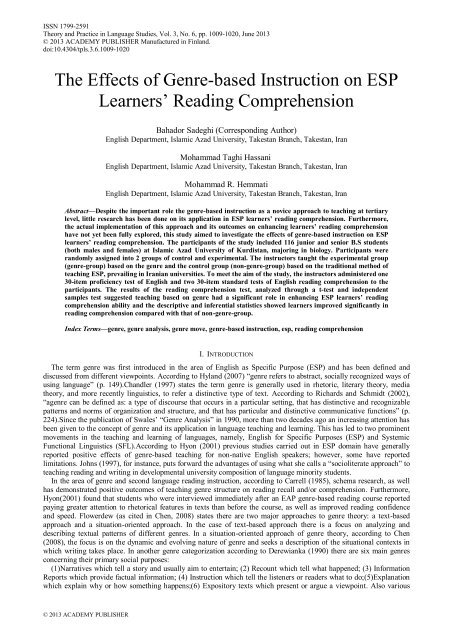Theory and Practice in Language Studies Contents - Academy ...
Theory and Practice in Language Studies Contents - Academy ...
Theory and Practice in Language Studies Contents - Academy ...
Create successful ePaper yourself
Turn your PDF publications into a flip-book with our unique Google optimized e-Paper software.
ISSN 1799-2591<strong>Theory</strong> <strong>and</strong> <strong>Practice</strong> <strong>in</strong> <strong>Language</strong> <strong>Studies</strong>, Vol. 3, No. 6, pp. 1009-1020, June 2013© 2013 ACADEMY PUBLISHER Manufactured <strong>in</strong> F<strong>in</strong>l<strong>and</strong>.doi:10.4304/tpls.3.6.1009-1020The Effects of Genre-based Instruction on ESPLearners‟ Read<strong>in</strong>g ComprehensionBahador Sadeghi (Correspond<strong>in</strong>g Author)English Department, Islamic Azad University, Takestan Branch, Takestan, IranMohammad Taghi HassaniEnglish Department, Islamic Azad University, Takestan Branch, Takestan, IranMohammad R. HemmatiEnglish Department, Islamic Azad University, Takestan Branch, Takestan, IranAbstract—Despite the important role the genre-based <strong>in</strong>struction as a novice approach to teach<strong>in</strong>g at tertiarylevel, little research has been done on its application <strong>in</strong> ESP learners’ read<strong>in</strong>g comprehension. Furthermore,the actual implementation of this approach <strong>and</strong> its outcomes on enhanc<strong>in</strong>g learners’ read<strong>in</strong>g comprehensionhave not yet been fully explored, this study aimed to <strong>in</strong>vestigate the effects of genre-based <strong>in</strong>struction on ESPlearners’ read<strong>in</strong>g comprehension. The participants of the study <strong>in</strong>cluded 116 junior <strong>and</strong> senior B.S students(both males <strong>and</strong> females) at Islamic Azad University of Kurdistan, major<strong>in</strong>g <strong>in</strong> biology. Participants werer<strong>and</strong>omly assigned <strong>in</strong>to 2 groups of control <strong>and</strong> experimental. The <strong>in</strong>structors taught the experimental group(genre-group) based on the genre <strong>and</strong> the control group (non-genre-group) based on the traditional method ofteach<strong>in</strong>g ESP, prevail<strong>in</strong>g <strong>in</strong> Iranian universities. To meet the aim of the study, the <strong>in</strong>structors adm<strong>in</strong>istered one30-item proficiency test of English <strong>and</strong> two 30-item st<strong>and</strong>ard tests of English read<strong>in</strong>g comprehension to theparticipants. The results of the read<strong>in</strong>g comprehension test, analyzed through a t-test <strong>and</strong> <strong>in</strong>dependentsamples test suggested teach<strong>in</strong>g based on genre had a significant role <strong>in</strong> enhanc<strong>in</strong>g ESP learners’ read<strong>in</strong>gcomprehension ability <strong>and</strong> the descriptive <strong>and</strong> <strong>in</strong>ferential statistics showed learners improved significantly <strong>in</strong>read<strong>in</strong>g comprehension compared with that of non-genre-group.Index Terms—genre, genre analysis, genre move, genre-based <strong>in</strong>struction, esp, read<strong>in</strong>g comprehensionI. INTRODUCTIONThe term genre was first <strong>in</strong>troduced <strong>in</strong> the area of English as Specific Purpose (ESP) <strong>and</strong> has been def<strong>in</strong>ed <strong>and</strong>discussed from different viewpo<strong>in</strong>ts. Accord<strong>in</strong>g to Hyl<strong>and</strong> (2007) “genre refers to abstract, socially recognized ways ofus<strong>in</strong>g language” (p. 149).Ch<strong>and</strong>ler (1997) states the term genre is generally used <strong>in</strong> rhetoric, literary theory, mediatheory, <strong>and</strong> more recently l<strong>in</strong>guistics, to refer a dist<strong>in</strong>ctive type of text. Accord<strong>in</strong>g to Richards <strong>and</strong> Schmidt (2002),“agenre can be def<strong>in</strong>ed as: a type of discourse that occurs <strong>in</strong> a particular sett<strong>in</strong>g, that has dist<strong>in</strong>ctive <strong>and</strong> recognizablepatterns <strong>and</strong> norms of organization <strong>and</strong> structure, <strong>and</strong> that has particular <strong>and</strong> dist<strong>in</strong>ctive communicative functions” (p.224).S<strong>in</strong>ce the publication of Swales‟ “Genre Analysis” <strong>in</strong> 1990, more than two decades ago an <strong>in</strong>creas<strong>in</strong>g attention hasbeen given to the concept of genre <strong>and</strong> its application <strong>in</strong> language teach<strong>in</strong>g <strong>and</strong> learn<strong>in</strong>g. This has led to two prom<strong>in</strong>entmovements <strong>in</strong> the teach<strong>in</strong>g <strong>and</strong> learn<strong>in</strong>g of languages, namely, English for Specific Purposes (ESP) <strong>and</strong> SystemicFunctional L<strong>in</strong>guistics (SFL).Accord<strong>in</strong>g to Hyon (2001) previous studies carried out <strong>in</strong> ESP doma<strong>in</strong> have generallyreported positive effects of genre-based teach<strong>in</strong>g for non-native English speakers; however, some have reportedlimitations. Johns (1997), for <strong>in</strong>stance, puts forward the advantages of us<strong>in</strong>g what she calls a “socioliterate approach” toteach<strong>in</strong>g read<strong>in</strong>g <strong>and</strong> writ<strong>in</strong>g <strong>in</strong> developmental university composition of language m<strong>in</strong>ority students.In the area of genre <strong>and</strong> second language read<strong>in</strong>g <strong>in</strong>struction, accord<strong>in</strong>g to Carrell (1985), schema research, as wellhas demonstrated positive outcomes of teach<strong>in</strong>g genre structure on read<strong>in</strong>g recall <strong>and</strong>/or comprehension. Furthermore,Hyon(2001) found that students who were <strong>in</strong>terviewed immediately after an EAP genre-based read<strong>in</strong>g course reportedpay<strong>in</strong>g greater attention to rhetorical features <strong>in</strong> texts than before the course, as well as improved read<strong>in</strong>g confidence<strong>and</strong> speed. Flowerdew (as cited <strong>in</strong> Chen, 2008) states there are two major approaches to genre theory: a text-basedapproach <strong>and</strong> a situation-oriented approach. In the case of text-based approach there is a focus on analyz<strong>in</strong>g <strong>and</strong>describ<strong>in</strong>g textual patterns of different genres. In a situation-oriented approach of genre theory, accord<strong>in</strong>g to Chen(2008), the focus is on the dynamic <strong>and</strong> evolv<strong>in</strong>g nature of genre <strong>and</strong> seeks a description of the situational contexts <strong>in</strong>which writ<strong>in</strong>g takes place. In another genre categorization accord<strong>in</strong>g to Derewianka (1990) there are six ma<strong>in</strong> genresconcern<strong>in</strong>g their primary social purposes:(1)Narratives which tell a story <strong>and</strong> usually aim to enterta<strong>in</strong>; (2) Recount which tell what happened; (3) InformationReports which provide factual <strong>in</strong>formation; (4) Instruction which tell the listeners or readers what to do;(5)Explanationwhich expla<strong>in</strong> why or how someth<strong>in</strong>g happens;(6) Expository texts which present or argue a viewpo<strong>in</strong>t. Also various© 2013 ACADEMY PUBLISHER
















